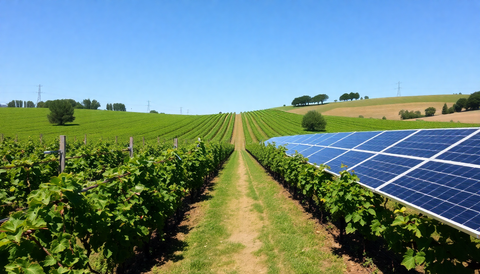Shiraz vs. Syrah: Uncorking the Delicious Differences
In the vast and intricate world of wine, certain grape varietals stand out for their global appeal and remarkable versatility. Among these, the grape known as Syrah (or Shiraz, depending on where it's grown and how it's made) holds a special place. It's a varietal that can craft wines of incredible elegance and complexity, as well as those that are bold, powerful, and bursting with fruit. But what exactly is the difference between Syrah and Shiraz? Are they two distinct grapes, or is there a more subtle explanation? The answer, while seemingly simple, reveals a fascinating story of geography, climate, and winemaking philosophy that shapes the final glass.
The Genesis of Syrah: A Journey from Ancient Roots
The story of Syrah begins not in Australia, as some might assume, but in the verdant vineyards of the Rhône Valley in France. Scientific research, including DNA analysis, has definitively traced the grape's origins to this esteemed region. Historical records and viticultural evidence point to its presence in the Northern Rhône for centuries, where it gained renown for producing wines of exceptional character. The name "Syrah" is traditionally associated with the wines from this northern area, characterized by its continental climate and steep, granite-based slopes. These wines are often celebrated for their aromatic intensity, balanced structure, and age-worthiness.
The Great Migration: How Syrah Became Shiraz
The journey from the Rhône Valley to global prominence is a captivating tale. While the exact circumstances of its spread are debated, it's widely accepted that European settlers, including the legendary James Busby, brought Syrah cuttings to Australia in the mid-19th century. Australia, particularly its warmer regions, proved to be an incredibly fertile ground for the grape. As the grape adapted to these new terroirs and winemakers developed distinct styles, the name "Shiraz" began to emerge and gain traction. This new moniker became synonymous with the ripe, powerful, and fruit-forward wines that defined Australian Syrah, particularly in iconic regions like the Barossa Valley.
Syrah: The Elegant and Aromatic Expression from Cooler Climates
When you encounter a wine labeled simply as "Syrah," especially from regions like the Northern Rhône (think prestigious appellations such as Hermitage, Côte-Rôtie, and Cornas), you can typically anticipate a wine that prioritizes finesse, aromatic complexity, and a structured palate. These wines are renowned for their sophisticated character, often showcasing:
- Aromatic Profile: Expect an intricate bouquet of aromas that can include floral notes like violet, classic black pepper spice, savory elements such as olive or cured meat, and dark fruit such as blackberry and plum. Subtle hints of smoke or even bacon fat can also emerge with age.
- Palate and Structure: Syrah from cooler climes typically presents a medium to full body with vibrant acidity and refined, well-integrated tannins. The fruit character tends to lean towards the savory and less overtly sweet, providing a refreshing counterpoint to the wine's structure. These are wines built for the long haul, capable of developing remarkable complexity over many years in the cellar.
- Winemaking Approach: Producers in these regions often favor traditional winemaking techniques that allow the inherent qualities of the grape and its terroir to shine through. This may involve judicious use of French oak to complement, rather than dominate, the wine's natural characteristics, and careful attention to fermentation and aging to preserve freshness and aromatic nuance.
The signature peppery note, often described as white or black pepper, is a hallmark of Syrah, lending it a distinctive savory edge. These wines are exceptionally versatile with food, pairing beautifully with dishes like roasted lamb, game meats, duck confit, and herb-infused stews.
Shiraz: The Bold and Fruit-Forward Powerhouse from Warmer Climates
Conversely, when a wine is labeled "Shiraz," particularly from Australia, it often signals a wine that is characterized by its bold fruit, generous body, and often higher alcohol content. Australian winemakers embraced the grape, and the name "Shiraz" became intrinsically linked to their signature style, especially in regions known for their warmth and sunshine, such as the Barossa Valley, McLaren Vale, and Hunter Valley. Key characteristics of these Shiraz wines include:
- Aromatic Profile: The warmer climate leads to riper fruit, so expect intense aromas of ripe blackberry, blueberry, plum, and often notes of dark chocolate, licorice, and sweet spice. A characteristic "confectionary" or jammy fruit note is also common, sometimes described as raspberry jam or fruit cake.
- Palate and Structure: Australian Shiraz typically delivers a full-bodied to very full-bodied experience on the palate, brimming with luscious, ripe fruit flavors. The tannins, while present, are often softer and more approachable in youth compared to cooler-climate Syrah, contributing to a plush, velvety texture. Wines from these regions can also achieve higher alcohol levels, contributing to their power and body.
- Winemaking Approach: Australian winemakers often aim to capture the essence of ripe fruit. Techniques such as extended maceration can be employed to maximize color and flavor extraction. Oak aging is common, with American oak often favored, which can impart distinct notes of vanilla, coconut, and spice, complementing the rich fruit profile.
Shiraz from Australia is often a crowd-pleaser, offering immediate satisfaction with its opulent fruit and smooth texture. It stands up magnificently to hearty fare such as grilled steaks, barbecue ribs, and rich, slow-cooked meat dishes.
Beyond the Climate: Factors Influencing Style
While geography and climate are primary drivers of the Syrah vs. Shiraz distinction, it's crucial to acknowledge that the winemaking itself plays an equally significant role in shaping the final wine. Several elements contribute to the stylistic variations:
- Terroir: Beyond just climate, the specific soil composition, elevation, aspect (direction the vineyard faces), and proximity to water bodies all influence how the Syrah grape develops. A Syrah grown on a cool, windy slope in Australia might exhibit more savory notes than one grown in a warmer, sunnier pocket within the same region.
- Winemaker's Intent: The philosophy and skill of the winemaker are paramount. A winemaker aiming for elegance might employ techniques to retain acidity and manage tannins carefully, regardless of the growing region. Conversely, a winemaker seeking maximum impact might embrace riper fruit and bolder oak treatments.
- Viticultural Practices: Decisions made in the vineyard, such as pruning methods, canopy management, irrigation strategies, and harvest timing, directly affect the ripeness, concentration, and balance of the grapes. Early harvesting generally leads to higher acidity and fresher fruit, while later harvesting results in riper fruit and higher potential alcohol.
- Oak Usage: The type of oak (French vs. American), the age of the oak (new vs. seasoned), and the toast level all impart distinct flavors and tannins to the wine. French oak tends to be more subtle, offering notes of spice and cedar, while American oak can bring prominent vanilla, coconut, and dill characteristics.
Global Expressions: Syrah/Shiraz Around the World
The influence of Syrah/Shiraz extends far beyond France and Australia. This adaptable grape has found remarkable success in many other wine-producing nations, each offering its own unique interpretation:
- United States: Washington State is a powerhouse for Syrah, often producing wines that balance Old World structure with New World fruit, exhibiting notes of dark fruit, olive, and a distinctive smoky character. California also produces excellent Syrah, with styles ranging from Rhône-like to bolder, fruit-driven examples.
- South Africa: South African Shiraz is highly regarded, often showcasing a wonderful balance of ripe fruit, peppery spice, and sometimes a smoky, meaty complexity. Regions like Stellenbosch and Swartland are particularly noted.
- Chile: Chilean Syrah is gaining international acclaim, often displaying vibrant fruit, floral notes, and a well-defined structure, sometimes with herbal or spicy undertones.
- Other Regions: Look for exciting Syrah/Shiraz expressions from New Zealand, Argentina, Italy (particularly Sicily), and even parts of Europe beyond France.
The Southern Rhône Connection: Blending Syrah
It's also worth noting that in the Southern Rhône Valley of France, Syrah is frequently used as a blending component alongside Grenache, Mourvèdre, and other indigenous grapes in wines like Gigondas, Vacqueyras, and Châteauneuf-du-Pape. In these blends, Syrah often contributes color, peppery spice, and structure, adding depth and complexity without dominating the overall profile. This demonstrates another facet of Syrah's adaptability and its role in creating nuanced, layered wines.
Conclusion: Embracing the Spectrum of Syrah/Shiraz
Ultimately, the distinction between Syrah and Shiraz is less about two different grapes and more about two distinct styles, largely dictated by climate and winemaking tradition. "Syrah" often evokes the elegant, peppery, and structured wines of cooler regions, while "Shiraz" typically points to the bold, fruit-forward, and opulent wines from warmer climates. However, the lines can blur, and the beauty of this varietal lies in its remarkable spectrum of expression.
Whether you are drawn to the refined complexity of a Northern Rhône Syrah or the unbridled power of an Australian Shiraz, the best way to understand the difference is to taste. Explore wines from different regions, compare labels, and pay attention to the tasting notes. By doing so, you'll not only deepen your appreciation for this incredible grape but also discover your personal preferences within its vast and delicious world. So, the next time you reach for a bottle, consider the story behind the name and enjoy the journey!




Comments (0)
There are no comments for this article. Be the first one to leave a message!